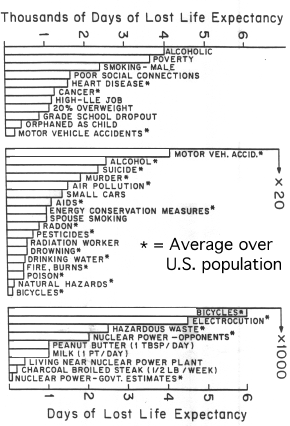
"Some showmanship activities are widely advertised as having very high accident potential, but judging from statistical experience, these dangers are exaggerated in the public mind. Professional aerialists � tight-rope walkers, trapeze artists, aerial acrobats, and high-pole balancers � get an LLE (Lowered Life Expectancy) of 5 days per year of participation, or 100 days from a 20-year career. The risk is similar for automobile and motorcycle racers of various sorts. The risk of accidental death in these professions therefore is less than in ordinary mining and construction work. The most dangerous profession involving thousands of participants is deep-sea diving, with an LLE of 40 days per year of participation.
In addition to accidents, occupational exposure causes many diseases that affect a worker's life span that in most cases are much more important than accidents. Coal miners, on an average, die 3 years earlier than the average man in the same socioeconomic status, and statistics are similarly unfavorable for truckers, fishermen, ship workers, steel erectors, riggers, actors and musicians (perhaps due to irregular hours), policemen, and firemen. On the other hand, there are occupational groups in which men live a year or more longer than average for their socioeconomic standing, such as postal workers, government officials, university teachers, and gardeners. Clearly, one's choice of occupation can have a large effect on one's life expectancy, extending to several years.
But by far the most dangerous occupation is no occupation � being unemployed. For this we use a study by Ray Marshall, former Secretary of Labor and now a professor at the University of Texas. Unemployment affects not only the worker himself, but his family and friends, and even those who remain employed because of stress caused by fear of losing their jobs. But if all of these effects were concentrated on the worker himself, the LLE from one year of unemployment would be about 500 days.
This is about equal to the risk of smoking 10 packs of cigarettes per day while unemployed.http://www.phyast.pitt.edu/~blc/book/chapter8.htmlAn interesting look at statistical risk.